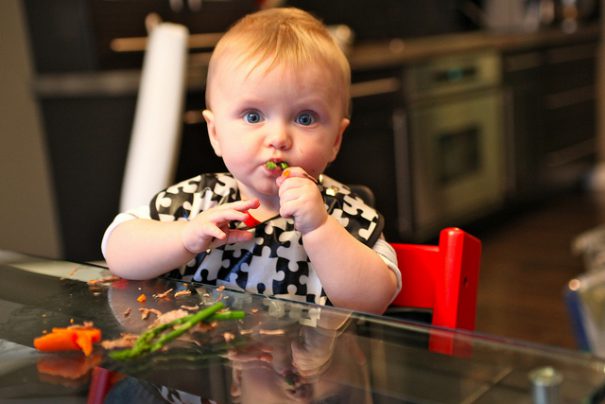Introducing solids to your baby for the first time can be a tricky territory. Feeling overwhelmed by taking on the time-consuming task of cooking homemade purees? Or not fond of buying pre-made baby food? There’s another way to introduce solids. Some parents skip the puree stage all together. How? By embarking on the feeding approach called baby-led weaning (BLW), a trend that’s gaining speed, probably because it makes feeding easier. Here are some of the basics.
Photo: Gail via Flickr
What is Baby-Led Weaning? (BLW)
In a nutshell, BLW means that you skip the spoon-feeding and puree stage of feeding first foods and instead let your baby feed themselves with finger foods. Since ‘food before one is mostly for fun!’, since babies are still getting most of their calories from formula or breast milk. So here, mealtime is more about your baby getting used to eating and trying different textures, than it is about providing all the essential nutrients in solid foods alone. Note: BLW should only be tried after 6 months of age. The American Academy of Pediatrics suggests starting solids around 6 months anyway, but some parents start as early as 3 to 4 months, which isn’t appropriate for the BLW style.
Why Some People Choose It
For many, BLW is all about simplicity. If you have more than one child, you might feel like you have less and less time to focus on making, storing, freezing and thawing out baby food. So opting to feed your littlest eater some of the same table food that the rest of your family is eating is nice and easy.
It’s also helpful when you don’t have to spoon-feed your baby at every single meal. By giving your little one a spoon and letting her attempt to give it a go, she has a great chance to practice those motor skills.
Some babies also seem to hate being spoon-fed. It comes down to personality. So if your baby refuses to let you feed him, or puts up a big fight when you get the spoon out, he may be an independent little soul and BLW may be worth a try.
You Don’t Have to Follow It Strictly
While true BLW advocates stick to the program exclusively, never giving a puree or spoon-feeding their baby. There is no reason you have to restrict yourself. Do what you feel is right at each meal. If you want to start breakfast by giving your baby a large spear of melon to gum and follow it up with spoon-fed oatmeal, go for it. You can create your own mash-up feeding style.
Photo: Nicole Abalde via Flickr
Types of Foods to Try
Steamed veggies and fruits (cut into strips so babies can hold them) are a great way to start. One favorite is steamed broccoli because it’s perfectly shaped for little hands to hold it and nibble on the top. Keep in mind that babies with no teeth should have very soft foods. So a steamer will likely become your best friend.
Some veggies to start with (always steamed and cut into strips), include:
- Sweet potatoes
- Broccoli
- Cauliflower
- Zucchini
- Carrots
- Asparagus tips
Cold cucumber strips are also awesome for chewing on when babies are teething.
Some soft fruits you can start with include:
- Banana (you can give Baby the whole thing!)
- Peach
- Nectarine
- Mango
- Avocado
- Melon
- Baked apple
After a while, scrambled eggs, shredded cheese, soft pastas or a soft piece of toast to nibble on are great options, too!
Photo: Kelly McCarthy via Flickr
Foods to Avoid
There are a few foods that most everyone will tell you to avoid before baby is one. Those include:
- Honey
- Cow’s milk
- Foods high in salt or sugar
- Nuts, popcorn, whole grapes, hot dogs, raisins, dried cranberries, and globs of PB (because these could all be considered choking hazards)
Speaking of Choking…
This is generally scary territory when it comes to kids – so BLW can seem strange or nerve-wracking. You’ll want to look into proper choking rescue procedures, consider an infant CPR certification (which many pediatrician offices offer and encourage anyway0 and consult with experts about what foods to avoid. But for the most part, choking is not a huge concern when babies feed themselves. Babies may gag when eating, whether through BLW or spoon-fed techniques, and this is a normal and healthy way for newbie eaters to handle the problem on their own. However, if your baby looks panicked or if his lips start turning blue, you know he’s choking.
Photo: Nadia Phaneuf via Flickr
What Some Parents Said
We asked around and found other parents who’ve tried BLW. Here are some of the things they had to say about why they chose it and how they did it.
“I had friends who did it and I liked that they didn’t have the hassle of cooking, pureeing, freezing and warming baby food.”
“I did it with both my girls. I started with zucchini, steamed so that it was pretty much mush when they put it in their mouth. It helps them to learn coordination and also saves money by not having to buy (as much) baby food!”
“Part of the reason I did it was to get her used to different textures so she wouldn’t end up a picky eater. And that totally didn’t work because she’s mega picky now. So you never know! But it was still easier for us.”
As always, be sure to consult with your pediatrician before starting solids and discuss your interests in trying Baby Led Weaning.
If you’ve tried it, what has your experience been? Share a comment with us!
–Heather Dixon











